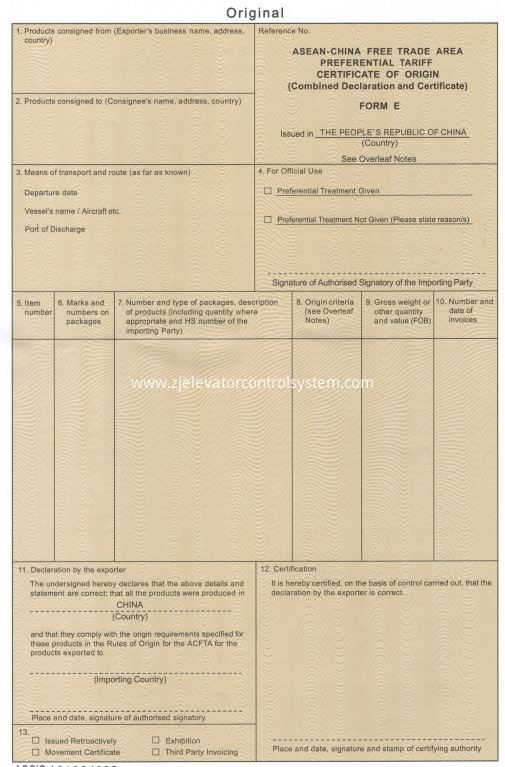
Mr. Jason LEE
Leave a message
Mr. Jason LEE
Leave a messageElevators and Escalators from CHINA to The ASEAN–China Free Trade Area (ACFTA)
Elevator Components from CHINA to The ASEAN–China Free Trade Area (ACFTA)
Elevator Spare Parts from CHINA to The ASEAN–China Free Trade Area (ACFTA)
Elevator Traction Machines from CHINA to The ASEAN–China Free Trade Area (ACFTA)
China Certificate of Origin – What An Importer Should Know
Certificate of Origin, also known as C/O or CO, is a shipping document which is used for certification that the products exported are wholly obtained, produced or manufactured in a particular Country.
This shipping paper is intended solely to prove the origin of goods in order to satisfy customs or trade requirements. Now it can be served as:
Most countries now are applying different customs duty rate upon imported commodities from different countries. In the specific conditions, import countries will provide different tariff treatment according to the C/O. While in some cases, tariff duty rates can make up a large part of the total laned cost.
Certificates of Origin should only be issued when they are actually needed, for example, in the following circumstances:
Check with your local Customs authority to see if you`ll benefit from getting a proper C/O. If yes, request CEP Team apply it for you. It`s an option at extra cost
Attention: For some countries such as Egypt/Saudi Arabia/Syria, a C/O is a must, no matter whether you can benefit from the duty discount.
ASEAN-CHINA FREE TRADE AREA
PREFERENTIAL TARIFF
CERTIFICATE OF ORIGIN
(Combined Declaration and Certificate)
FORM E
Issued in THE PEOPLE'S REPUBLIC OF CHINA
Applied to following countries: Brunei, Cambodia, Indonesia, Laos, Malaysia, Myanmar, Philippines, Singapore, Thailand and Vietnam.

The ASEAN–China Free Trade Area (ACFTA), also known as China–ASEAN Free Trade Area is a free trade area among the ten member states of the Association of Southeast Asian Nations (ASEAN) and the People's Republic of China. The initial framework agreement was signed on 4 November 2002 in Phnom Penh, Cambodia, with the intention to establish a free trade area among the eleven nations by 2010. The free trade area came into effect on 1 January 2010. The ASEAN–China Free Trade Area is the largest free trade area in terms of population and third largest in terms of nominal GDP.
ASEAN members and the People's Republic of China had a combined nominal gross domestic product of approximately US$6 trillion in 2008 The free trade area had the third largest trade volume after the European Economic Area and the North American Free Trade Area.
| Flag | Country | Capital | Area(km2) | Population (2008 unless noted) | GDP (nominal) (bln USD, 2008, IMF) | Currency | Official languages |
|---|---|---|---|---|---|---|---|
| | Brunei Darussalam | Bandar Seri Begawan | 5,765 | 490,000 | 19.7 | dollar | Malay |
| | Burma (Myanmar) | Naypyidaw | 676,578 | 50,020,000 | 26.2 | kyat | Burmese |
| | Cambodia | Phnom Penh | 181,035 | 13,388,910 | 11.3 | riel | Khmer |
| | Indonesia | Jakarta | 1,904,569 | 230,130,000 | 511.8 | rupiah | Indonesian |
| | Laos | Vientiane | 236,800 | 6,320,000 | 5.4 | kip | Lao |
| | Malaysia | Kuala Lumpur | 329,847 | 28,200,000 | 221.6 | ringgit | Malay, English |
| | Philippines | Manila | 300,000 | 100,981,437 (2015) | 166.9 | peso | Filipino, English |
| | Singapore | Singapore | 707.1 | 4,839,400 (2007) | 181.9 | dollar | Malay, Mandarin, English, Tamil |
| | Thailand | Bangkok | 513,115 | 63,389,730 (2003) | 273.3 | baht | Thai |
| | Vietnam | Hanoi | 331,690 | 88,069,000 | 89.8 | đồng | Vietnamese |
| | People's Republic of China | Beijing | 9,640,821 | 1,338,612,968 (2009) | 4,327.4 | renminbi | Mandarin |
The free trade agreement reduced tariffs on 7,881 product categories, or 90 percent of imported goods, to zero. This reduction took effect in China and the six original members of ASEAN: Brunei, Indonesia, Malaysia, the Philippines, Singapore and Thailand. The remaining four countries will follow suit in 2015. The average tariff rate on Chinese goods sold in ASEAN countries decreased from 12.8 to 0.6 percent on 1 January 2010 pending implementation of the free trade area by the remaining ASEAN members. Meanwhile, the average tariff rate on ASEAN goods sold in China decreased from 9.8 to 0.1 percent.
The six original ASEAN members also reduced tariffs on 99.11 percent of goods traded among them to zero.
Previous: Chinese Elevator Market Reaching Peak
Next: 5-star Customer Services

Privacy statement: Your privacy is very important to Us. Our company promises not to disclose your personal information to any external company with out your explicit permission.

Fill in more information so that we can get in touch with you faster
Privacy statement: Your privacy is very important to Us. Our company promises not to disclose your personal information to any external company with out your explicit permission.